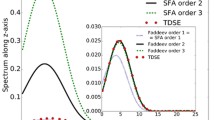Abstract
We investigate theoretically the spectrum of weak probe field absorption by three-level atoms with the Λ configuration of levels in the field of a strong electromagnetic wave acting on an adjacent transition and colliding with buffer gas atoms. Analysis is carried out for the general case of arbitrary collisional relaxation of low-frequency coherence at a transition between two lower levels. It is shown that, in the absence of collisional relaxation of low-frequency coherence, the probe field spectrum always exhibits clearly manifested anisotropy with respect to mutual orientation of wavevectors of the strong and probe radiation (even under small Doppler broadening). It is found that the probe field spectrum may acquire under certain conditions supernarrow resonances with a width proportional to the diffusion coefficient for atoms interacting with radiation. This fact may form the basis for a spectroscopic method for measuring transport frequencies of collisions between absorbing and buffer particles. A large-amplitude supernarrow resonance (with an amplitude much larger than the amplitude of the resonance near the line center), which is observed in the far wing of the absorption line, exhibits collisional narrowing (a nonlinear spectroscopic analog of the Dicke effect) at collision frequencies several orders of magnitude lower that the Doppler linewidth. Simple working equations proposed for describing the probe field spectrum are convenient for experimental data processing.
Similar content being viewed by others
References
S. G. Rautian, G. I. Smirnov, and A. M. Shalagin, Nonlinear Resonances in Atomic and Molecular Spectra (Nauka, Novosibirsk, 1979) [in Russian].
A. K. Popov, Introduction in Nonlinear Spectroscopy (Nauka, Novosibirsk, 1983) [in Russian].
V. S. Letokhov and V. P. Chebotaev, High-Resolution Nonlinear Laser Spectroscopy (Nauka, Moscow, 1990) [in Russian].
B. J. Feldman and M. S. Feld, Phys. Rev. A 5, 899 (1972).
M. Kaivola, P. Thorsen, and O. Poulsen, Phys. Rev. A 32, 207 (1985).
A. D. Wilson-Gordon, Phys. Rev. A 48, 4639 (1993).
V. G. Arkhipkin, A. K. Popov, and A. S. Aleksandrovskii, Pis’ma Zh. Éksp. Teor. Fiz. 59, 371 (1994) [JETP Lett. 59, 398 (1994)].
Yu. I. Belousov, E. V. Podivilov, M. G. Stepanov, and D. A. Shapiro, Zh. Éksp. Teor. Fiz. 118, 328 (2000) [JETP 91, 287 (2000)].
S. A. Babin, E. V. Podivilov, V. V. Potapov, et al., Zh. Éksp. Teor. Fiz. 121, 807 (2002) [JETP 94, 694 (2002)].
Yu. I. Belousov and D. A. Shapiro, J. Phys. B: At. Mol. Opt. Phys. 36, 1495 (2003).
W. Happer, Phys. Rep. 44, 169 (1972).
B. D. Agap’ev, M. B. Gornyi, B. G. Matisov, and Yu. V. Rozhdestvenskii, Usp. Fiz. Nauk 163(9), 1 (1993) [Phys. Usp. 36, 763 (1993)].
E. Arimondo, Prog. Opt. 35, 257 (1996).
M. O. Skalli and M. S. Zubairi, Quantum Optics (Fizmatlit, Moscow, 2003) [in Russian].
O. Kocharovskaya, Phys. Rep. 219, 175 (1992).
A. K. Popov, Izv. Ross. Akad. Nauk, Ser. Fiz. 60, 99 (1996).
J. Mompart and R. Corbalan, J. Opt. B: Quantum Semiclassic. Opt. 2, R7 (2000).
A. I. Parkhomenko and A. M. Shalagin, Zh. Éksp. Teor. Fiz. 120, 830 (2001) [JETP 93, 723 (2001)].
S. Chapman and T. G. Cowling, Mathematical Theory of Non-Uniform Gases, 2nd ed. (Cambridge Univ. Press, Cambridge, 1952; Inostrannaya Literatura, Moscow, 1960).
Handbook of Mathematical Functions, Ed. by M. Abramowitz and I. A. Stegun (Dover, New York, 1971; Nauka, Moscow, 1979).
Author information
Authors and Affiliations
Additional information
__________
Translated from Zhurnal Éksperimental’no\(\overset{\lower0.5em\hbox{$\smash{\scriptscriptstyle\smile}$}}{l}\) i Teoretichesko\(\overset{\lower0.5em\hbox{$\smash{\scriptscriptstyle\smile}$}}{l}\) Fiziki, Vol. 128, No. 6, 2005, pp. 1134–1144.
Original Russian Text Copyright © 2005 by Parkhomenko, Shalagin.
Rights and permissions
About this article
Cite this article
Parkhomenko, A.I., Shalagin, A.M. Probe field spectroscopy in three-level Λ systems under arbitrary collisional relaxation of low-frequency coherence. J. Exp. Theor. Phys. 101, 989–998 (2005). https://doi.org/10.1134/1.2163916
Received:
Issue Date:
DOI: https://doi.org/10.1134/1.2163916




